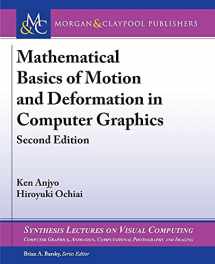
Mathematical Basics of Motion and Deformation in Computer Graphics: Second Edition (Synthesis Lectures on Visual Computing: Computer Graphics, Animation, Computational Photography and Imaging)
ISBN-13:
9781627056977
ISBN-10:
1627056971
Edition:
2
Author:
Brian A. Barsky, Hiroyuki Ochiai, Ken Anjyo
Publication date:
2017
Publisher:
Morgan & Claypool Publishers
Format:
Paperback
96 pages
FREE US shipping
Book details
ISBN-13:
9781627056977
ISBN-10:
1627056971
Edition:
2
Author:
Brian A. Barsky, Hiroyuki Ochiai, Ken Anjyo
Publication date:
2017
Publisher:
Morgan & Claypool Publishers
Format:
Paperback
96 pages
Summary
Mathematical Basics of Motion and Deformation in Computer Graphics: Second Edition (Synthesis Lectures on Visual Computing: Computer Graphics, Animation, Computational Photography and Imaging) (ISBN-13: 9781627056977 and ISBN-10: 1627056971), written by authors
Brian A. Barsky, Hiroyuki Ochiai, Ken Anjyo, was published by Morgan & Claypool Publishers in 2017.
With an overall rating of 3.8 stars, it's a notable title among other
Graphics & Design
(Graphics & Multimedia, Programming, Software Design, Testing & Engineering, Applied, Mathematics) books. You can easily purchase or rent Mathematical Basics of Motion and Deformation in Computer Graphics: Second Edition (Synthesis Lectures on Visual Computing: Computer Graphics, Animation, Computational Photography and Imaging) (Paperback) from BooksRun,
along with many other new and used
Graphics & Design
books
and textbooks.
And, if you're looking to sell your copy, our current buyback offer is $0.3.
Description
This synthesis lecture presents an intuitive introduction to the mathematics of motion and deformation in computer graphics. Starting with familiar concepts in graphics, such as Euler angles, quaternions, and affine transformations, we illustrate that a mathematical theory behind these concepts enables us to develop the techniques for efficient/effective creation of computer animation. This book, therefore, serves as a good guidepost to mathematics (differential geometry and Lie theory) for students of geometric modeling and animation in computer graphics. Experienced developers and researchers will also benefit from this book, since it gives a comprehensive overview of mathematical approaches that are particularly useful in character modeling, deformation, and animation.


We would LOVE it if you could help us and other readers by reviewing the book
Book review

Congratulations! We have received your book review.
{user}
{createdAt}
by {truncated_author}


